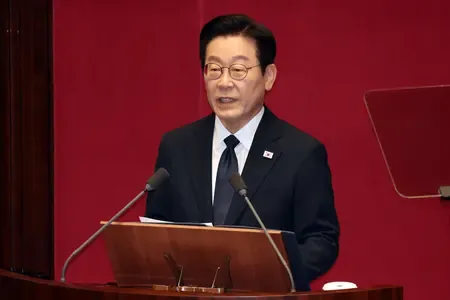Is it a natural expectation for South Korea's nuclear submarine to counter China?

Synopsis
Key Takeaways
- The US anticipates South Korea's nuclear submarine will play a key role in countering Chinese threats.
- Admiral Caudle emphasizes the need for enhanced US-South Korea military cooperation.
- South Korea's naval capabilities are expected to transition to a global scale.
- Monitoring North Korea's advancements in naval technology is crucial.
- Collaboration on various vessels can proceed with fewer legal hurdles.
Seoul, Nov 16 (NationPress) The US chief of naval operations has indicated that it would be a “natural expectation” for Washington to foresee the South Korean Navy utilizing a nuclear-powered submarine, once constructed, to assist in addressing threats from China.
Admiral Daryl Caudle expressed this sentiment following the United States' formal endorsement of South Korea's initiative to acquire its inaugural nuclear-powered submarine, as outlined in a joint fact sheet released last week. This fact sheet highlighted the discussions held during the summit between President Lee Jae Myung and US President Donald Trump on October 29.
“The deployment of that submarine for countering China, I believe, is a natural expectation,” Caudle stated to reporters during a group interview on Friday, when queried about the nuclear submarine's potential role in countering China and transforming the South Korean Navy's function in the broader East Asian region, as reported by Yonhap News Agency.
“With such capabilities, I think the United States would anticipate that partnership, once again, working in alliance to achieve our shared objectives regarding what the US perceives as its pacing threat—China. I believe, to a large extent, Korea shares concerns about China as well, making this capability an integral part of the equation.”
The US has been urging its allies to enhance their defense expenditures and contribute to “collective defense” as it seeks to fortify collaboration with its partners amidst escalating Sino-US rivalry.
During their summit in the southeastern city of Gyeongju, Lee also candidly requested Trump to permit his nation to obtain nuclear fuel supplies for conventionally armed submarines to better monitor North Korean and Chinese vessels, explaining that this would alleviate the operational burden on US forces.
Given the strategic importance of a nuclear-powered submarine, which he noted “brings a whole different level of capability for deterrence,” the top US naval officer stated that operating such a vessel will likely place greater responsibilities on the South Korean Navy, both regionally and globally.
“As the saying goes, with great power comes great responsibility. I believe Korea will have a responsibility to deploy those submarines globally, transitioning from merely a regional navy to a global navy,” Caudle remarked.
When questioned about the potential construction site of the envisioned submarine—whether in South Korea or a US shipyard acquired by South Korean conglomerate Hanwha as Trump had indicated on social media—the US naval chief stated that this matter should be directed to the White House.
However, even without the nuclear submarine project being finalized, Caudle emphasized the importance of a robust partnership between South Korea and the US in countering China’s grey zone activities, advocating for a model based on peace through strength.
“We observe this kind of activity globally, and it raises significant concerns. This is why our collaboration with Korea is so crucial. A strong deterrent mechanism is necessary to prevent such activities between our two nations,” he stated. “My earnest goal, alongside the US Seventh Fleet, US Pacific Fleet, and other joint force partners, along with Korea, is to assert that this behavior will not be tolerated.”
Against this backdrop, Caudle mentioned that conducting combined naval drills in international waters of the Yellow Sea to address China's threats is “certainly not off the table,” although he refrained from providing operational specifics. Currently, such exercises primarily occur in the eastern and southern waters off the Korean Peninsula.
Caudle, whose visit to South Korea includes inspections of shipyards, expects South Korea to play a “prominent” role in enhancing the US's shipbuilding capabilities.
While acknowledging the existence of legal challenges for cooperation concerning combat vessels, he mentioned that supply ships, auxiliary ships, fuel tankers, and car carriers are types of vessels that both nations can collaborate on “immediately” with minimal restrictions.
When asked about North Korea's efforts to bolster its naval capabilities, Caudle pointed out that while North Korea does not present a naval threat to the US, diligent monitoring is essential to mitigate its activities that could be perceived as threats to South Korea. He highlighted underwater drone technology as an area that requires countermeasures.
“I am concerned about the use of unmanned capabilities beneath, on, and above the sea. We need to monitor this closely and devise appropriate countermeasures to safeguard against these evolving technologies.”









